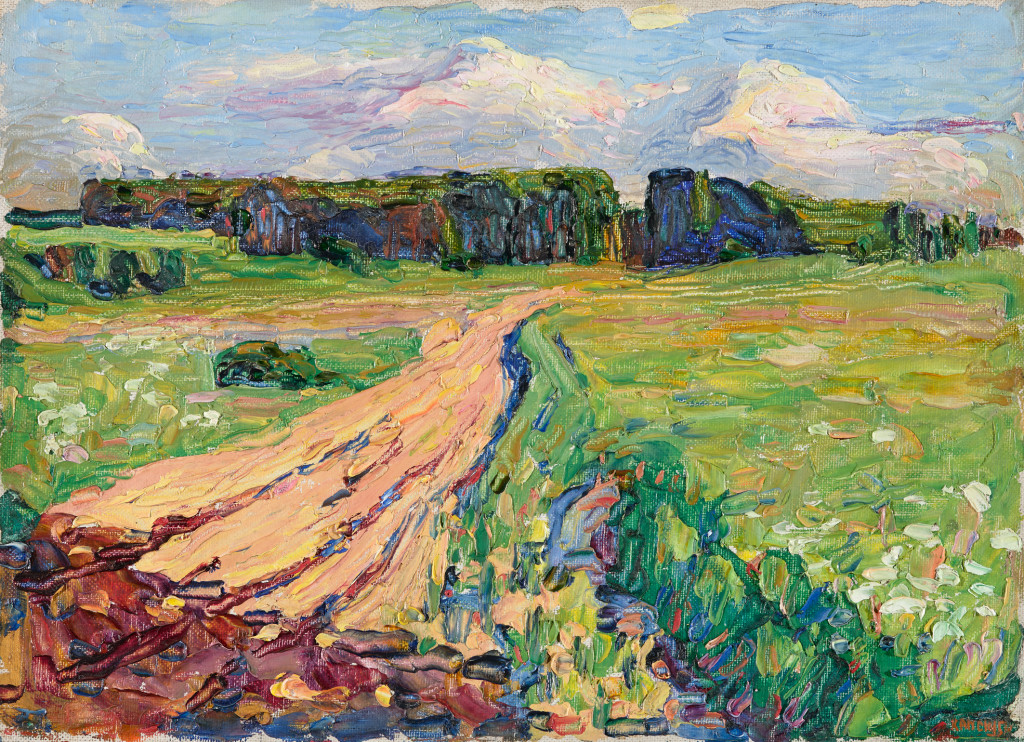Wassily Kandinsky (Moscow 1866 - 1944 Neuilly-sur-Seine)
Planegg I – Landscape near Munich, c.1901
Oil on canvas, laid down on cardboard, 23.5 x 32.8 cm
Signed lower right KANDINSKY
Inscribed on the verso Planegg b. München / Kandinsky / No. 74
Provenance:
Private auction in the studio of Adolf Erbslöh in support of the ‛Neue Künstlervereinigung München’ on 15 March 1911, Munich[1]
Dr. Fröhner, Munich (acquired for 50 gold marks at the sale above)
Galerie Aktuaryus, Zurich
Galerie Änne Abels, Cologne
Galerie Jan Dik, Munich (1966 or 1968)
Georg Schäfer private collection, Schweinfurt
German private collection
Exhibited:
Van Gogh und die Moderne, Essen, Museum Folkwang, August-November 1990; Amsterdam, Rijksmuseum Vincent van Gogh, November 1990-February 1991, Freren 1990, no. 169a, repr. p. 383
Der frühe Kandinsky. 1900-1910, Berlin, Brücke Museum, September-November 1994; Kunsthalle Tübingen, December 1994-February 1995, Munich 1994, no. 5, repr.
Wassily Kandinsky, Tra Monaco e Mosca. 1896-1921, Rome, Museo Centrale del Risorgimento, October 2000-February 2001, Rome 2000, p. 59, repr.
Künstler sehen Bayern. Bayern lässt staunen. Gemälde und Zeichnungen aus der Sammlung des Museums Georg Schäfer, Schweinfurt, Museum Georg Schäfer, May-October 2013, Schweinfurt 2013, p. 110, no. 41, repr. p. 111
Literature:
Will Grohmann, Wassily Kandinsky, 1866-1944. Leben und Werk. Cologne 1958, p. 343, no. 74, not repr. (‘74’ is the number Kandinsky gave the work in his catalogue of small painted sketches)
Hans K. Roethel and Jean Benjamin, Kandinsky. Werkverzeichnis der Ölgemälde 1900-1944, Munich 1982, I, p. 65, no. 20, repr.
Kandinsky: Wege zur Abstraktion. Malerei 1908 -1921, H. Fischer, S. Rainbird and B. Kaufmann (eds.), exhib. cat., London, Tate Modern, June-October 2006; Basel, Kunstmuseum, October 2006-February 2007, Basel and Ostfildern 2006, p. 22, repr
Planegg I was executed at a time when Kandinsky’s career was centred on Munich. His work at the turn of the twentieth century focused chiefly on landscapes. It also marked a resurgence of his interest in Russian folk art, combining its motifs and formal vocabulary with features of Art Nouveau and Symbolism. He studied briefly at the Munich Academy under Franz von Stuck and some of his work reflects Stuck’s influence. In 1901, the year in which Planegg I was painted, Kandinsky co-founded the avant-garde artists’ association known as ‘Phalanx’. Monet and the Neo-Impressionist Signac exhibited with ‘Phalanx’ and their handling of colour was to have an important impact on Kandinsky’s painting.
The present work belongs to a group of landscapes executed in the years 1901 to1908 which reflect the influence of van Gogh and the Post-Impressionists.[1] Some were painted in the countryside near Munich, others on Kandinsky’s travels with Gabriele Münter in the years 1903-4 and during their extended stay in Sèvres in 1906-7. The short brushstrokes and bright dots and dabs of colour owe much to divisionism. However Kandinsky’s palette is brighter and its impact intenser.
[1] In Kandinsky’s hand-written Hauskataloge – the handlists of his own works – he distinguishes between ‘pictures’ [Bilder], ‘small oil studies’ [kleine Ölstudien], ‘coloured drawings’ [farbige Zeichnungen] and ‘decorative sketches’ [dekorative Skizzen]. See Will Grohmann, Wassily Kandinsky, 1866-1944. Leben und Werk, Cologne 1958, p. 329ff.
The village of Planegg lies in the countryside west of Munich and in the early years of the twentieth century represented something of a popular outing for city residents. Kandinsky’s Planegg depicts a simple rural scene. It is strikingly devoid of detail such as figures and buildings, and depicts a farm track cutting through high meadows towards the edge of a forest. In the far distance mountain peaks appear to merge with banks of sunlit cloud. The palette is bright and the landscape is suffused with the glare of summer light. Paint is applied in staccato, near-rectangular touches and in some areas, with a palette knife. Kandinsky’s use of colour is not descriptive but infused with intuitive energy. The painting surpasses realistic depiction of external appearances and Kandinsky’s impressions take it to an introspective intellectual level.[2]
Commenting on his early studies made before the motif, Kandinsky noted: When I painted studies I let myself go. Thinking little of houses and trees, I applied coloured bands and spots to the canvas, making them sing out as loudly as I could.[3]
[1] Gabriele Münter made a sketch of the works sold by Kandinsky at the auction. See Hans K. Roethel and Jean Benjamin, Kandinsky. Werkverzeichnis der Ölgemälde 1900-1944, Munich 1982, I, p. 21.
[2] For a discussion of Kandinsky’s early landscapes, see also Rosel Gollek, Wassily Kandinsky. Frühe Landschaften, Munich 1978; Der frühe Kandinsky. 1900-1910, Berlin, Brücke Museum, September-November 1994; Tübingen, Kunsthalle, December 1994-February 1995, Munich 1994; Hai-Young Song, Wassily Kandinsky. Von den frühen Landschaften zur Komposition (1901-1911), Regensburg 1995; Reinhard Zimmermann, ‛Kandinsky. Der Weg zur Abstraktion’, in Kandinsky. Malerei 1908-1921, Basel 2006, p. 22f.
[3] Hans Konrad Roethel and Jelena Hahl-Koch (eds.), Wassily Kandinsky 1866-1944. Die gesammelte Schriften, Bern 1980, p. 36.

